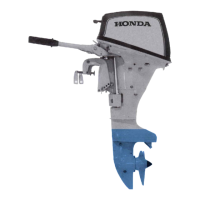
Do you have a question about the Honda 75 and is the answer not in the manual?
Check engine oil level, ensuring it is clean and leak-free before operation.
Details on recommended gasoline grade, engine oil capacity, and type.
Information on the fuel tank's capacity and the required type of gasoline.
Safety warnings regarding gasoline flammability and proper handling procedures.
Ensure water is expelled from the check pipe after starting the engine for cooling.
Inspect propeller, fuel line, steering handle for damage and proper connection.
Verify the presence of spare parts and the complete tool kit for maintenance.
Select a boat compatible with engine power and ensure correct transom height.
Install motor centrally at rear, with anti-cavitation plate 4cm below boat bottom.
Securely fasten the stern bracket with clamp screws and check their tightness.
Adjust the motor's tilt angle so the propeller axis is parallel to the water surface.
Change adjusting rod position to set the propeller axis angle in 4 stages.
Verify fuel level, connect fuel line, and prime the engine using the primer bulb.
Steps for engaging neutral, aligning throttle, using choke, and pulling starter cord.
Increase speed by twisting throttle grip towards FAST, avoid full throttle for normal cruising.
Select gears (F, N, R) and operate steering handle for boat direction.
Steps to tilt the engine to raise propeller out of water in shallow areas.
Turn throttle to SHIFT, move shift lever to NEUTRAL, and press stop button to halt the engine.
Disconnech fuel, drain carburetor, and follow cold weather precautions.
Carry by handle or lock lever; transport vertically or horizontally as shown.
Wash engine exterior with fresh water and clean interior by running in fresh water.
Apply marine anti-corrosion grease to specific parts like shift shaft and clamp screws.
Details on periodic maintenance tasks and their recommended service intervals.
Information on where to find the attached tool kit and spare parts for maintenance.
Steps for draining old oil, refilling with new oil, and checking the level using the dipstick.
How to check, fill, and change gear case oil, and identify water presence.
Cleaning, inspecting, and adjusting spark plug gap for optimal performance.
Adjusting the resistance of the throttle grip for smoother operation.
Adjusting the steering handle's resistance using a 6mm bolt.
Steps to replace a broken shear pin to protect the propeller and engine from damage.
How to start the engine using a spare rope if the recoil starter fails.
Steps to take and precautions before sending a submerged engine for service.
Common fuel-related causes for the engine failing to start.
Common ignition and electrical causes for the engine failing to start.
Fuel-related causes for the engine cutting out during operation.
Ignition/electrical causes for the engine cutting out.
Details on output, throttle range, engine type, displacement, and ignition system.
Information on lubrication system, specified oils, and oil capacities for engine and gear case.
Specifications for cooling, exhaust, fuel pump, fuel type, and tank capacity.
Details on steering, tilt angle, dimensions, transom height, propeller, and dry weight.
Information on available manuals and how to obtain them for maintenance and repair.
Guidance on contacting Honda Marine for service and problem resolution, including necessary details.